Mar-09-11
 | | An Englishman: Good Evening: Is it my febrile imagination, or did both players overlook 52...Ra3X? |
|
Aug-26-23
 | | KEG: Janowski, who had begun the tournament with 5.25 points in the first six rounds (under the strange scoring system in effect at Monte Carlo 1902) had then faltered and fallen to sixth place. In this 16th round, he was driving to get back on top of the standings. He probably expected an easy win against Reggio who was in next-to-last place and ultimately lost all of his games to each of the top 15 players. But Reggio surprised Janowski in the opening here, and held his own until move 60 (apart from a bizarre incident noted on this site by <An Englishman> in which both sides overlooked mate in one on move 52. Playing over the game, one can almost feel Janowski's frustration as he tried to find a way to win what looked like a clearly drawn endgame. Fortunately for Janowski, Reggio erred on move 60, placing himself in jeopardy if not a losing position, and then blundered terribly on move 61 ending his chances and after which Janowski cleaned up. With this win, after Round 16, the standings were:
Maroczy---11.5
Pillsbury--11.0
Marshall--10.0
Tchigorin-- 9.75 (but with half a game less to play)
Janowski--9.50 (with a half a game more to go)
Tarrasch--9.50
The "half-games" I refer to were replays in which only a half-point was at stake. Teichmann, who had four extra replays, had 7.75 points. It is hard to know where to slot him at this point. Anyhow, he're the Reggio--Janowski game.
1. e4 e5
2. d4
The Center Game. Hard to explain this choice of opening by Reggio here. 2... exd4
3. Qxd4 Nc6
4. Qe3 Be7
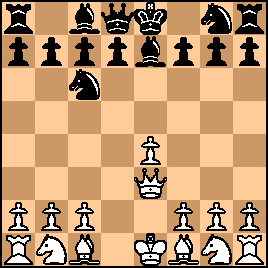
click for larger view4...Nf6 is more usual and looks natural. But the text was later played at least twice by Alekhine, and--more significantly--was played by Janowski himself in his win against Winawer at Nuremberg 1896. In any case, it can transpose to the normal lines if 5...Nf6 is played. 5. Nc3 Nf6
6. Qg3?!
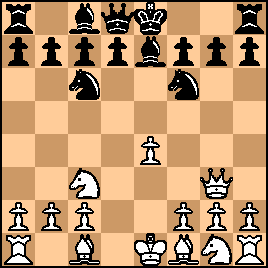
click for larger viewA wild attempt to attack. Winawer played exactly this move in his above-cited loss to Janowski at Nuremberg 1896. Did Reggio know of the earlier game? If so, did he think he had found an improvement? 6... 0-0?!
Daring White to attack instead of the more natural and stronger-looking 6...d5! Janowski had played this (inferior in my view) move against Winawer. Was Reggio counting on Janowski repeating his previous line? 7. Bh6!
As Winawer had played. Janowski must have known this was coming: 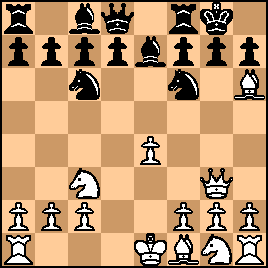
click for larger view |
|
Aug-26-23
 | | KEG: Post II
7... Ne8
"!"--(Tournament Book)
"Idea Bh4"--(Tournament Book)
8. Bf4 d6
Still following his 1896 game against Winawer. 9. 0-0-0!
Still following Winawer. Clearly h4 will come soon. 9... Be6
As in the earlier game, shunning 9...Bh4 which seemed to be the idea behind 8...Ne8. 10. h4
As expected.
10... Bf6

click for larger view11. Nd5
Reggio's "improvement" on Winawer's 11. Bg5. The choice seems one of style. Other possibilities included developing the g1 Knight with 11. Nge2 and bringing the White King to safety with 11. Kb1. 11... BxN
A shocking decision coming from Janowski, who loved Bishops. I would have expected 11...Be5 from him, selling his dark-square Bishop for its counter-part rather than for a Knight. Another good choice would have been 11...Ne7. 12. exB Ne7

click for larger view13. Bd3
11. Qa3 or 11 h5 or 11. Bc4 seem to be better ways to carry on his attack. 13... Qd7?!
The defensive 13...c6 looks best. But Janowski generally--as here--chose the most complex lines rather than objectively best defensive moves. With his f6 Bishop eyeing b2, Janowski had visions of attack in his sights, and gave Reggio chances. 14. c3?
"Blunting the attack on b2 and making Bb1 possible"--(Tournament Book) The text, however, gave Janowski dangerous counter-chances. Instead, a better way to "blunt" Black's attack was with 14. Kb1. Alternatively, he could have continued with his attack with 14. Nh3 or 14. h5. The position was now:

click for larger view14... Nxd5?!
Janowski played much of this game as if he believed he was destined to win against his unquestionably weaker opponent. Otherwise, why would he have allowed Reggio his following combo that gave White the better game and superior chances, especially since he could just have played 14...Qa4 here. 15. Bxh7+ KxB
16. Qd3+
16. RxN looks about equally good.
16... Kg8
17. QxN
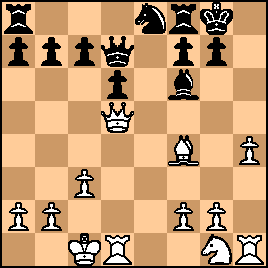
click for larger viewJanowski probably expected this position to arise and had already prepared his upcoming counter-measure. But even with this, White is better and Janowski would require some good fortune to win this game. |
|
Aug-26-23
 | | KEG: Post III
17... Qa4
"Well played! Attacking the Bishop and forcing the exchange of Queens to prevent the loss of the a2-pawn"--(Tournament Book). 18. Be3
18. g3 or 18. Ne2 were perhaps more accurate.
18... c6
19. Qb3 QxQ
Janowski could not have been happy to enter a slightly inferior ending at this point, but any other move could have been trouble for him. 20. axQ Be7

click for larger viewEven with White's Knight still on its original g1 square, his game has more active and probably theoretically superior. What Janowski probably liked is the this endgame is unbalanced (I would expect Magnus Carlsen to win from either side of the board here). Objectively, White has no reason to fear losing with sound play. As will be seen, however, neither player had any intention of pursuing stolid lines: 21. g4?!
"!"--(Tournament Book)
"Planning to advance to g5 in the event of f5"--(Tournament Book) Unless Reggio had telepathy, how could he count on 21...f5 from Janowski here. Theoretically better for White were 21. h5 or just to develop his Knight with 21. Nf3 or maybe 21. Ne2. 21... f5?!
Reggio apparently knew Janowski's proclivities. Black here could more simply play 21...Nf6 or 21. d5 without the potentially weakening text. 22. g5
So Reggio got this move in, with a little help from his opponent. But Janowski had a fine retort available to him. 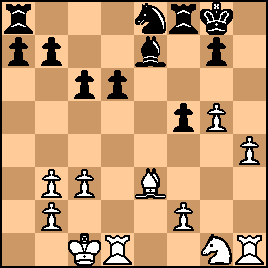
click for larger view22... a5?!
As so often was the case, Janowski played like...Janowski and wanted a slugfest. The rest of us might just play 22...f4! Black would then be in little danger. 23. Ne2
The White Knight decides to make an appearance! But 23. Nf3 looks simpler. After the text, Janowski had a seemingly obvious route to avoid trouble: 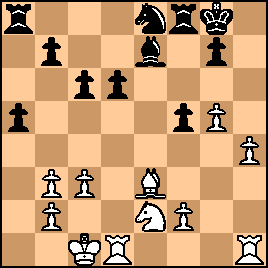
click for larger view23... a4?!
23...d5 looks obvious. But not to Janowski who seems to have been hell-bent on blowing Reggio off the board. 24. b4?!
Reggio also appears to have wanted the wild-west show to continue. He could just have played 24. Kc2! or 24. bxa4 with much the better (theoretical) chances. 24... d5
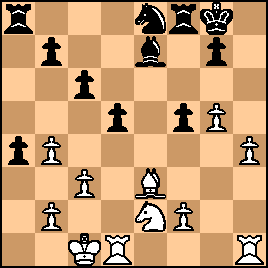
click for larger view25. h5
"?"--(Tournament Book)
"Premature. Correct was either f4 or Nf4. The text loses his positional advantage"--(Tournament Book) Actually, the text is far from a blunder, though the best moves were probably 25. Kc2 or 25. Nd4 (or perhaps 25. Rde1). The text was not best because it allowed Janowski to spring a clever equalizing combination that seemingly led to a clear draw (though not with these guys at the board). The position was now:

click for larger view |
|
Aug-27-23
 | | KEG: Post IV
25... f4!
"!"--Tournament Book
"A well calculated combination"--(Tournament Book) 26. Bxf4
26. Nxf4 Bxg5 27. Nxd5+ BxB+ 28. NxB Rxf2 29. Rdf1 RxR+ 30. RxR was slightly superior and would have left Reggio with arguably a tiny edge. After the text, the game soon reduced to an entirely equal and likely drawn ending. 26... RxB!
The point of Janowski's combination.
27. NxR Bxg5

click for larger viewAfter the dust ultimately settles, Black is fine. But how could he hope to win from here? 28. Rd4 Nc7
28...Bf6 also draws, perhaps by repetition, e.g. 29. Rd3 Bg5 30. Rd4 etc. The text, which prepares 29...Nb5 easily saves the day for Black. But that, of course, would not be sufficient for Janowski's purposes. 29. Kb1
The White King has to get off the c1...h6 diagonal sooner or later. 29... Nb5

click for larger view30. Ne6
Reggio could also have played 30. Rg1 or 30. Nh3. 30... NxR
31. Nxg5 Nb5

click for larger viewReggio was now nominally up a pawn. But this was of no import, and a draw seems to be in sight. What now followed was Janowski's desperate efforts to make something out of nothing. 32. Re1 Kf8
33. Ne6+ Kf7
34. Ng5+ Kf6
35. Nh7+ Kf7
36. Ng5+
Reggio was obviously satisfied with repeating the position and achieving a draw. Janowski was clearly now keen on allowing this, so he avoided playing Kf6 here. 36... Kf8
37. Ne6+ Kf7
38. Ng5+
Reggio perhaps did not notice that he could here have claimed a draw by triple repetition. 38... Kf6
39. Nh7+ Kf5
"Risky"--(Tournament Book)
Not it wasn't. As will be seen, Janowski had anticipated Reggio's next move. 40. Re7
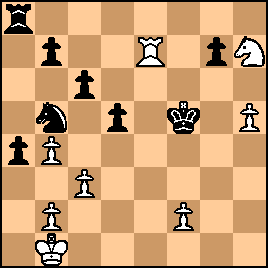
click for larger view40... a3!
Well played.
41. Ka2
41. Rxg7 d4! 42. Rf7+ Ke4 43. Ng5+ Kd5 44. Rf3 also gets White nothing but a draw. 41... axb2
41...Ra4 was also sufficient to draw.
42. Kxb2 Nd6
43. Rxg7

click for larger viewOnce again, Reggio was nominally up a pawn, and yet again this meant nothing and the game should end in a draw. So Janowski had to continue his campaign toe create some route to be able to play for a win. What followed became very strange. |
|
Aug-27-23
 | | KEG: Post V
43... Ke4
43...Re8 was probably the easiest way to play for a draw, but Janowski wanted action. Theoretically, the text involves little or no risk. But Janowski probably though this was the best way to play for complications. 44. Rg3
44. Kc1 was probably simpler, but there is nothing wrong with the text either. 44... Rh8
He could also have played 44...Nc4+, also with a likely draw. 45. Rg7 Ra8
45...Kd3 is also fine for Black.
46. Rg3
Again seemingly ready to take a draw by repetition. 46... Rh8
47. Rg7 Kd3
Avoiding a draw by repetition which could have transpired after 47...Ra8 48. Nf6 Nc4+
49. Kb3 Rf8
50. Rg6

click for larger viewNot much had happened for a while. But beginning here, things heated up and got crazy. 50... b5
"!"--(Tournament Book)
Beginning to construct a mating net that almost ended the game. 51. f4
Forced!
51... Ra8
Continuing to weave the net, and with the not-so-subtle threat of 52...Ra3 checkmate! 
click for larger viewReggio now obviously had to play 52. Rg3+ to avoid mate in one. But... 52. Rg2???
Hard to believe:

click for larger viewAs <An Englishman> has pointed out, Janowski could now have mated Reggio on the spot with 52...Ra3+ 52... Ke3??
Is it plausible that Reggio, Janowski, and the Tournament Book commentator all overlooked what <An Englishman> has pointed out? Or is there something amiss with the game score? Beats me. Anyway, after the reported 52...Ke3???, the position was: 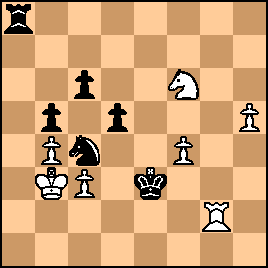
click for larger view53. Ra2
"?"--(Tournament Book)
According to the Tournament Book, Reggio later on demonstrated that he could have drawn with 53. Rg8. That is true enough. But the text (like a whole bunch of other moves now draws for Black, especially since by moving his king on his last turn there is no longer an immediate mating threat. I see no basis for assigning a "?" to 53. Ra2. The game is theoretically still a draw. 53... Nd2+
54. Kb2 Rf8
Trading Rooks here would obviously lose immediately. 55. Kc1

click for larger viewHow on earth did Janowski (Black) manage to win from here, you might rightly ask. Stay tuned. |
|
Aug-27-23
 | | KEG: Post VI
55... Nf3
55...RxN 56. RxN Rh6 57. Rh2 Kxf4 58. Kd2 would also be a likely draw but would leave Black with no winning chances I can perceive (and some work to hold the draw). 56. Ng4+
Best
56... Kxf4

click for larger view57. Nh2
Anything else would court trouble.
57... Kg3
Probably forced.
58. NxN RxN
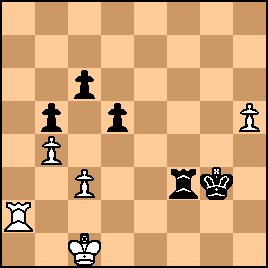
click for larger viewSure looks like a draw.
59. Ra8 Kg4
59...Rxc3+ 60. Kd2 Rc4 61. Rg8+ Kh2 62. h6 Rh4 63. Rg6 Rxb4 64. Rxc6 Rh4 65. Rg6 would be a dead draw. After 59...Kg4, the position was:

click for larger view60. Rh8?
"?"--(Tournament Book)
White had a clear route to a draw with 60. Rc8 or 60. h6. The Tournament Book's suggested 60. Rg8+ Kxh5 61. Kc2 would likely also lead to a draw, but was not the easiest line. The Tournament Book claimed that 60. Rh8 was "The losing move." However, as we shall see, it is less than clear that White is now lost. This was the final move before the move-60 time control. It is therefore remarkable that--whatever Reggio's current status--he blundered away any chance to save the game with his next move. 60... Rxc3+

click for larger view61. Kd2?
Now the game is utterly lost for White. Reggio would have retained chances with 61. Kb2 [or 61. Kb1] Rc4 62. Kb3 Kg5 63. Rh7 Rf4 64. 64. Rh8 Re4 65. Rh7 and it is difficult to see how Black can make progress. After the text, however:
61... Rc4

click for larger viewReggio's King was now horribly placed and the position was a clear win for Black. Thus, I would call 61. Kd2 the true "losing move." And Reggio now make matters even worse for himself (if such could truly be possible). |
|
Aug-27-23
 | | KEG: Post VII
62. Kd3?
If Reggio wanted to play on, he had to try 62. h6 or 62. Rh7. Now, after the text, the house came down on him. 62... Kg5
"!"--(Tournament Book)
There were other winning moves for Black here (62...Kh4; 62...Kf5) but this was the most accurate. 63. h6 Kg6

click for larger view64. Kd2?
Worse than surrender. 64. Re8 was the only way to prolong the game even a little bit. 64... Rxb4

click for larger view65. R38
A ridiculous move, but everything else was a loser, so I guess it didn't matter. 65... Rc4
Janowski could also have just played 65...Rd4+ 66. Kc2 Rc4+ 67. Kd3 Kxh6. But the text was more than sufficient: 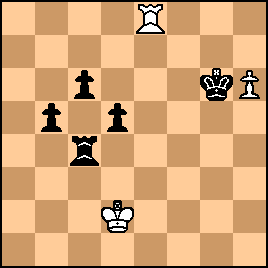
click for larger view0-1 |
|
Aug-27-23
 | | nizmo11: <Keg: Is it plausible that Reggio, Janowski, and the Tournament Book commentator all overlooked what <An Englishman> has pointed out? Or is there something amiss with the game score?> A suggestion: Perhaps the game score is missing a move pair, and the game went 52...Rg3+ 53.Kd2, and now
53...Rg2+ (with check) 54. Ke3 Ra2
This way there is no missed mate. |
|
Sep-02-23
 | | KEG: <nizmo11> That might (I perhaps should say "must") be the solution. Otherwise, everybody seems to have lost their minds, including the annotators. Another fine contribution by <nizmo11> Thank you. |
|
Sep-02-23
 | | perfidious: <nizmo11>'s suggestion must be right; certainly the idea is logical and Reggio was more than capable of seeing this method of getting out of trouble. |
|
Sep-02-23
 | | KEG: <perfidious> I agree completely. |
|
|
|
|





